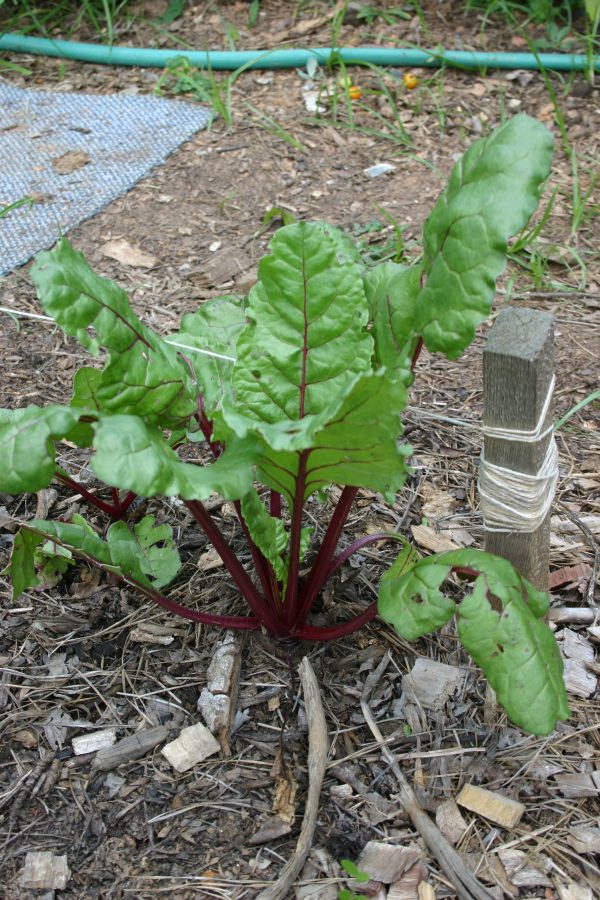Beet

Beta vulgaris
Garden beets are closely related to sugar beets and to Swiss chard. All are the same species and are members of the goosefoot family. Beets originated in the maritime regions of Europe, and gardeners hybridized them in Germany and England in the middle of the sixteenth century.
• More detailed information can be found in The Georgia Fruit & Vegetable Book by Walter Reeves and Felder Rushing
• See also:
Beets are the main ingredients in borscht, but that is certainly not the only way to enjoy them. People love beets both for their globe-shaped roots and their leafy tops.
WHEN TO PLANT
Because beets will stand a frost, you may sow them 1 month before the frost-free date (the average date of last frost). Make successive plantings at 20-day intervals until midsummer to have a continuous supply of fresh beets.
WHERE TO PLANT
These root crops require well-prepared loamy soil. Beets do best in a soil that is neutral to alkaline (remember that a pH of 7.0 is neutral; above 7.0, the soil is alkaline; below 7.0, the soil is acidic.) If soil tests point to acidic soil, add lime. Do not apply lime or gypsum to garden soils unless they have been tested to determine whether they need the added calcium. The soil should also have a high potassium level, essential for good root development. Drainage is important, especially if you desire to start the plants early, so that the soil is dry enough to work. Plant beets in a full-sun location (8 to 10 hours will suffice), and they will reward you with a full crop.
HOW TO PLANT
Apply a complete garden fertilizer, such as 10-10-10, at a rate of 11/2 pounds per 100 square feet of garden. Work the soil into a fine seedbed (make sure that the soil is finely broken up; see “Soil Preparation” in the introduction to the vegetable garden). Poor germination will result from soil that is not well prepared. In rows, sow beet seeds 1 inch apart, and allow 12 to 15 inches between rows. In a raised bed, sow the rows 8 to 10 inches apart across the bed. Cover the seeds with 1/2 inch of fine soil. For summer seedings, place a board over each row to keep the soil from drying or from being compacted by pounding rain. Check twice a day to see whether the seedlings have begun to emerge, and remove the board as soon as you notice them. Beet seeds are actually dried-up fruits; each contains 2 or more seeds, so don’t plant them too close together. When the seedlings are large enough to handle, thin them to 1 to 3 inches apart. You can recognize the beet seedlings because they will appear in rows and all look the same; weed seedlings will appear at a random spacing, and all will look different. If you wait until the seedlings are about 3 inches tall, you can cook them as greens.
CARE AND MAINTENANCE
These plants require little care. Hoe or pull the weeds so that they don’t compete with the beets for water and nutrients. If no rain falls for 7 to 10 days, apply 1 inch of water; beets that develop in dry weather will be fibrous and woody. Plants may be affected by leaf spots, leaf miner insects, or root maggots; be prepared to use an approved insecticide or fungicide according to label directions.
ADDITIONAL INFORMATION
Red beets are notorious for “bleeding” all over the counter and sink. The yellow and white varieties don’t have this problem. Harvest tops when they are 6 inches high, and use them as you would use spinach. Harvest roots when they are 11/2 to 2 inches in size. Beets allowed to grow more than 3 inches in diameter will be tough and woody. Dig late-season beets, and store them in pits of sand or in boxes of sand in a cool place, such as a garage. Or store them in plastic bags with air holes. Keep them at a temperature just above freezing; don’t let them freeze.
VARIETIES
Variety Name
Days to Maturity
Comments
HYBRID
Avenger
57
Greens
Big Red
55
Late Season
Gladiator
48
Good for canning
Pacemaker
50
Early
Red Ace
53
Good in hot weather
INBRED
Crosby’s Egyptian
56
Uniform, sweet, dark red
Detroit Dark Red
58
Tender
Early Wonder
52
Flattened
Ruby Queen
60
Top Quality. AAS
Sangria
56
Keeps shape even when crowded
Sweetheart
58
Tops good for greens.
SPECIALTY
Bull’s Blood
35
Antique variety with deep red tops
Burpee’s Golden
55
Yellow
Cylindra
60
Long, cylindrical
Green Top Bunching
65
Superior tops for greens
Little Ball
50
1 ¬Ω Inches At Maturity
The old standby varieties are open pollinated (inbred). Inbred varieties are not necessarily inferior, and they include a recent AAS winner. More recent varieties include hybrids, which are not necessarily better, just newer (and costlier).















